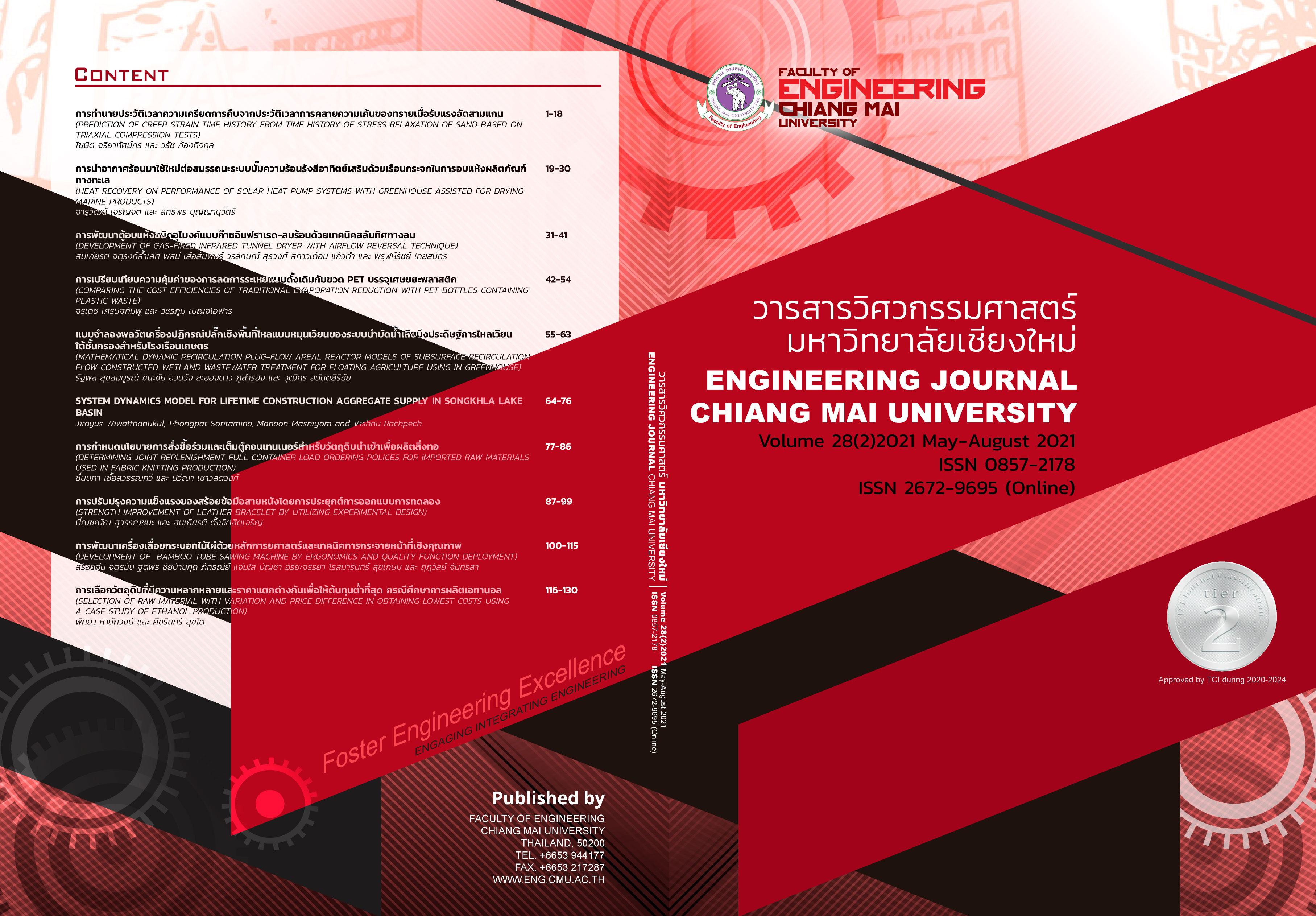Prediction of Time History of Creep Strain from Time history of Stress Relaxation of Sand in Triaxial Compression
Keywords:
Creep, Stress relaxation, Triaxial Compression Test, Sand, Strain RateAbstract
Most geotechnical engineering materials exhibit behaviours responded to the loading rate effect, which are due to their viscous property, e.g., creep (CP) by sustained loading, stress relaxation (SR) by keeping the strain constant, stress jump upon a stepwise change in the strain rate, etc. Precise prediction of creep strain is important for evaluation of the long-term performance of a soil structure under a constant working load. This research performed a series of special drained triaxial compression tests on KMUTT sand samples. Various loading histories were applied so as to evaluate viscosity type and investigate the CP and SR behaviours at various values of stress ratio. An analytical framework was developed from systematic relationships between the elapsed times necessary to reach the same irreversible strain rate in CP and SR tests and those between the irreversible strain increments necessary to reach the same irreversible strain rate in CP and SR tests. The followings are found. KMUTT sand exhibits the behaviours responded to the loading rate effect by which the viscosity type is TESRA in the pre-peak regime translated to P&N in the post-peak regime. Time history of CP can be precisely predicted by time history of SR performed for a much shorter time. And, time factor from the prediction increases with increasing stress ratio.
References
Tatsuoka, F., (2007), Inelastic Deformation Characteristics of Geomaterial, Soil Stress-Strain Behavior: Measurement, Modeling and Analysis, March 2007, pp 1-108.
Tatsuoka, F., Di Benedetto, H., Enomoto, T., Kawabe, S. and Kongkitkul, W., (2008), Various Viscosity Types of Geomaterials in Shear and Their Mathematical Expression, Soils and Foundations, Vol. 48(1), pp. 41-60.
Duttine, A., Tatsuoka, F., Salotti, A. and Ezaoui, A., (2015), Creep and Stress Relaxation Envelopes of Granular Materials in Direct Shear. paper presented in Proc. of 15th Pan-American Conference on Soil Mechanics and Geotechnical Engineering and 6th International Conference on Deformation Characteristics of Geomaterials, Buenos Aires.
Jardine, R.J., Standing, J.R. and Kovacevic, N., (2005), Lessons Learned from Full Scale Observations and the Practical Application of Advanced Testing and Modelling. Proceedings of the 3rd International Symposium on Deformation Characteristics of Geomaterials, Lyon, France, Vol. 2, pp. 201-245.
Furudoi, T. and Kobayashi, M., (2009), Geotechnical Issues and Approach on Kansai International Airport Project—Prediction and Performance of Settlement, J. Soc. Civ. Eng. Ser. C, Vol. 65(4), pp. 998-1017.
Lade, P. and Karimpour, H., (2010), Static Fatigue Controls Particle Crushing And, Soils and Foundations, Vol. 50, pp. 573-583.
Nuntapanich, N., Kongkitkul, W., Tatsuoka, F. and Jongpradist, P., (2018), Prediction of Creep Behaviour from Load Relaxation Behaviour of Polymer Geogrids, Geosynthetics International, Vol. 25(3), pp. 334-349.
Tatsuoka, F. and Haibara, O., (1985), Shear Resistance between Sand and Smooth or Lubricated Surfaces, Soils and Foundations, Vol. 25(1), pp. 89-98.
Santucci de Magistris, F., Koseki, J., Amaya, M., Hamaya, S., Sato, T. and Tatsuoka, F., (1999), A Triaxial Testing System to Evaluate Stress-Strain Behavior of Soils for Wide Range of Strain and Strain Rate, Geotechnical Testing Journal, Vol. 22(1), pp.44-60.
Kongkitkul, W., Hirakawa, D. and Tatsuoka, F., (2007), Viscous Behaviour of Geogrids; Experiment and Simulation, Soils and Foundations, Vol. 47(2), pp. 265-283.
Downloads
Published
Issue
Section
License
ลิขสิทธิ์ของบทความที่ตีพิมพ์ในวารสารฉบับนี้จะยังเป็นของผู้แต่งและยินยอมให้สิทธิ์เผยแพร่กับทางวารสาร
การเผยแพร่ในระบบวารสารแบบเปิดนี้ บทความจะสามารถนำไปใช้ได้ฟรีในการศึกษา และในทางที่ไม่เกี่ยวกับการค้า




